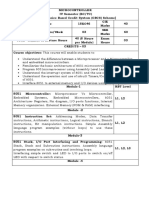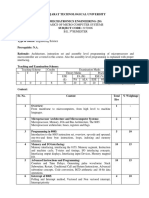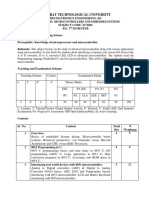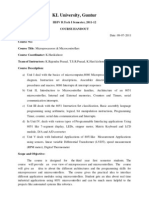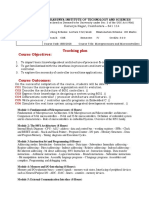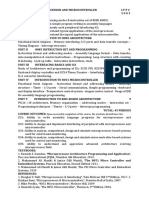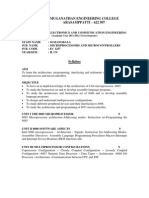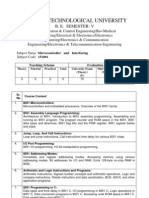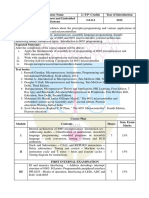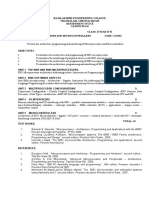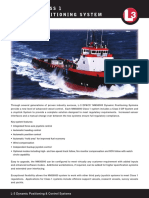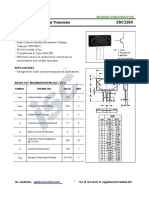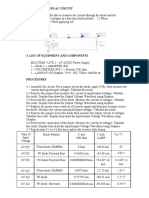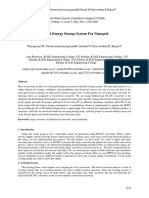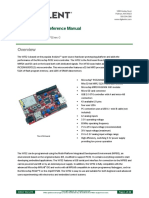Course No.
Course Name L-T-P-Credits Year of
Introduction
IC206 MICROCONTROLLERS 3-0-0-3 2016
Prerequisite : Nil
Course Objectives
To learn the architecture of a microcontroller
To learn the instruction set of a microcontroller
To be able to program a microcontroller in assembly language
To be able to program a microcontroller in a high level language
To be able to interface memory with a microcontroller
Syllabus
Architecture of an eight bit microcontroller- Instruction set the microcontroller- Programming
the microcontroller in Assembly language and in a high level language -Interfacing memory and
input/output devices to the microcontroller.
Expected Outcome
Students should be able to comprehend, design and implement a microcontroller based system
complete both in hardware and software aspects for various purposes
Text Books:
1. Muhammed Ali Mazidi and Janice Gillispie Mazidi, The 8051 Microcontroller and
Embedded Systems using Assembly and C, Pearson Education, 2e.
2. Manish K. Patel, The 8051 based embedded systems, McGraw Hill Education (India), 2014.
References:
1. Kenneth J Ayala, The 8051 Microcontroller, Cengage Learning, 3e
2. Ramani Kalpathi and Ganesh Raja, Microcontrollers and Applications, Sanguine Technical
Publishers, 2009
3. Raj Kamal, Microcontrollers Architecture, programming, interfacing and system design,
Pearson, 2e.
Course Plan
Sem.
Module Contents Hours Exam
Marks
Evolution of microcontrollers-comparison with microprocessors-
Classification of microcontrollers-state of the art-significance of
3
embedded systems- Overview of Intel 8051 family of
microcontrollers- Harvard and Von Neumann Architectures
I 15%
Architecture of Intel 8051-ALU, internal RAM and ROM,
Oscillator and Reset Circuits, basic timing diagram, Stack and
3
stack pointer-Special Function Registers of 8051- Organization of
ports
Comparison of machine language, assembly language and high
level languages, Assembler directives-Intel hex format- 2
Addressing modes of 8051
II 15%
Instruction set of 8051- Data transfer instructions, Arithmetic,
logical, compare and rotate instructions- Bit processing 5
instructions- Program flow control instructions
� FIRST INTERNAL EXAM
Assembly language programming of 8051: Examples illustrating
the use of all types of instructions. Programming the ports of 5
8051.
III 15%
An introduction to programming 8051 in C language- Additional
data types for 8051-illustrative examples of C programming for 3
8051
Timers of 8051: All modes of operations, programming the
timers in assembly language and C language, timer as an event
3
counter, frequency measurement using timers, pulse width
measurement using timers.
IV Serial Communication with 8051: Introduction to serial 15%
communication, synchronous and asynchronous communication,
RS232 protocol, all modes of operations including multiprocessor 4
mode. Serial communication programming in assembly language
and C language
SECOND INTERNAL EXAM
Interrupt system of 8051: introduction to interrupts- comparing
polling scheme with interrupt system- interrupts in 8051-priority
of interrupts- Interrupt handling and execution for timer, external 4
and serial interrupts. Programming to handle all types of
V interrupts in assembly language and C language. 20%
Interfacing external memory to Intel 8051: Introduction to
various types of memory-memory mapping and address
3
decoding-Examples of Interfacing data memory and code
memory
Interfacing input and output devices: Interfacing LCD to 8051-
Interfacing matrix keyboard-Interfacing ADC and DAC-
VI 7 20%
Interfacing sensors- Interfacing relays, stepper motors and DC
motors. An introduction to I2C protocol
END SEMESTER EXAM
QUESTION PAPER PATTERN:
Maximum Marks: 100 Exam Duration: 3 Hours
There shall be three parts for the question paper.
Part A includes Modules 1 & 2 and shall have three questions of fifteen marks out of which
two are to be answered. There shall be subdivisions, limited to a maximum of 4, in each
question.
Part B includes Modules 3 & 4 and shall have three questions of fifteen marks out of which
two are to be answered. There shall be subdivisions, limited to a maximum of 4, in each
question.
Part C includes Modules 5 & 6 and shall have three questions of twenty marks out of which
two are to be answered. There shall be subdivisions, limited to a maximum of 4, in each
question.
Note: Each part shall have questions uniformly covering both the modules in it.

